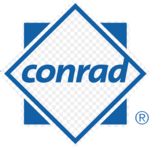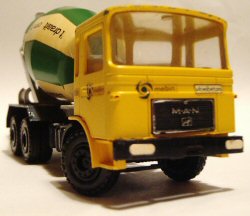Conrad Models facts for kids
 |
|
| GmbH | |
| Founded | 1923 |
| Headquarters | |
| Products | Die-cast scale model commercial vehicles |
Conrad GmbH is a German company that makes cool die-cast scale model trucks. These models are super detailed, often used as toys or as special promotional items for big construction companies. Conrad is special because it's one of the few European companies that still makes its models in Europe, not in places like China.
Conrad Modelle is located in Kalchreuth, a town near Nuremberg in Germany. In the past, they also made model cars.
How Conrad Started
The company that came before Conrad was called Gescha. It started way back in 1923. The name "Gescha" might have come from a German abbreviation, "Ges. Gesch.", which means "trademark registered".
Gescha used to make wind-up toys out of tin, similar to other famous toy companies like Schuco Modell. The Conrad family started making die-cast models in 1956. At first, Gescha used "Conrad" as a sub-brand for these new die-cast models.
Most of the detailed truck and heavy equipment models that Conrad is known for were sold under the Gescha name in the 1960s and 1970s. But as the 1970s went on, the name Conrad became more popular. By around 1980, the Gescha name was no longer used.
Since 1987, Gunther Conrad has been in charge of the company, with help from his wife Gerde and their son, Michael. This means Conrad has stayed a family-owned business for a long time.
Awesome Models Today
Today, Conrad makes over 90 different models! Most of these are trucks and cranes. Their models look very similar to those made by another company called NZG Models. Both companies make very detailed and well-finished die-cast models.
While NZG Models often focuses on construction and earth-moving machines, Conrad makes more types of commercial trucks. They also create unique models like huge stationary construction cranes, tunnel boring machines, and even jackhammer trucks.
Sometimes, you might see NZG Models sold under the Conrad name, but usually, the two companies work separately. For example, Conrad used to make models of Caterpillar construction vehicles until about 1990. After that, NZG took over the license for Caterpillar models.
Conrad models are known for their amazing details. For instance, their Volvo 470 F16 Intercooler Globetrotter truck with a refrigeration tanker had tiny details like an opening back door on the tanker. This door showed cooling gauges and other parts inside! There were even detailed cooling fins underneath the tanker, which you could only see if you turned the model upside down.
The prices for Conrad construction models can vary a lot. Smaller models, like a Moffett forklift, might cost around $55 (Australian dollars). Larger, more complex models, like some of the Liebherr tower cranes, can cost over $1,900 (Australian dollars).
Cool Die-cast Cars from the Past
In the 1980s, Conrad also made promotional model cars, mostly in a 1:43 scale. These cars were very well made, just like those from other German companies such as Schuco Modell.
Conrad mainly focused on making models of Volkswagen cars, like the Polo, Passat, Santana, Scirocco, and the Type 2 van. They also made Audi models, including the Coupé, 100 sedan, and the Quattro.
Conrad also made a few Mercedes-Benz models, like the 280TE wagon and the 190E sedan. Some Mercedes-Benz models were made in a slightly larger 1:35 scale. This was probably because the real car companies wanted them that way.
Conrad, like NZG, stopped making car models after the 1980s. They decided to focus more on their popular trucks and construction equipment models.
Special Packaging
Conrad model cars came in boxes that looked very similar to those from other German manufacturers like NZG and Cursor. The boxes were usually silver and had a standard design, often with pictures of vehicles on the flaps and big blue letters on the sides.
This similar packaging shows that the real car companies often decided how the model cars should look and be sold. The model companies worked closely with the car manufacturers to meet their specific needs. This was different from how toy companies in other countries sometimes worked.
Because the packaging was so similar, it could sometimes be confusing. It wasn't always clear on the box if a model was made by Conrad, NZG, or Cursor. You might even think that Mercedes-Benz itself made the model!



